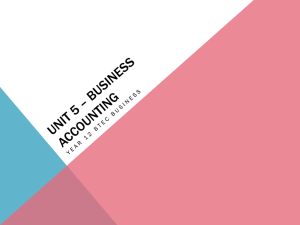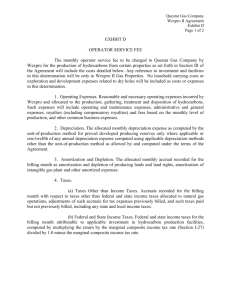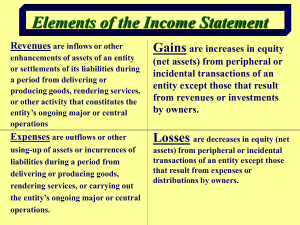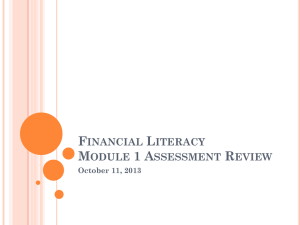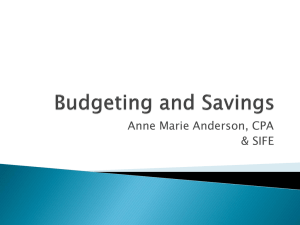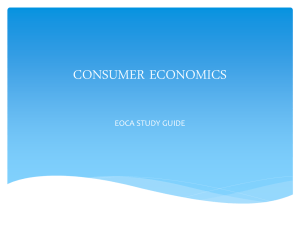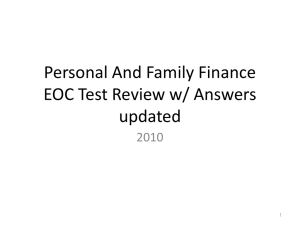Accounting Fundamentals for Managing and Sustaining Profitability
advertisement
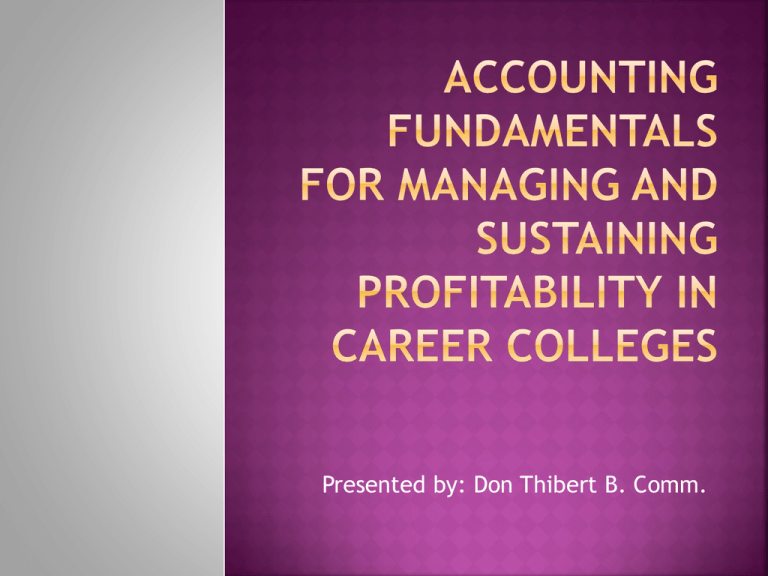
Presented by: Don Thibert B. Comm. A one year program is $12,000. You earn $12,000/12 months or $1,000/Month. Or $12,000/52 weeks or $230.77/Week. Or $230.77/5 days or $46.15/Day. Estimating monthly Revenue Budgeting Business Other Plan examples? Revenue less expenses = Net Income Fixed Expenses: Variable Expenses: Rent Textbooks Marketing Student supplies Payroll Office vs Faculty Utilities What are your conclusions about expenses? Most of our costs are fixed? What if variable costs are $100 per month per student. Our run rate (Revenue) is $1,000 from our previous example. So variable costs are 10% of Revenue per month. Contribution towards fixed expenses is therefore 90% of monthly Revenue What if fixed expenses are $30,000/Month. You would need $30,000/90% in Revenue to cover fixed expenses or $33,333.33 Income Statement: Revenue Variable Expenses Contribution Fixed Expenses Net Income $33,333.33 3,333.33 $30,000.00 $30,000.00 0 Break Even = $33,333.33 or 33 students/month Income Statement: Revenue (38 X 1,000) Variable Expenses Contribution Fixed Expenses Net Income $38,000.00 3,800.00 $34,200.00 $30,000.00 4,200.00 Once you have passed Break-even every new student has 90% of revenue flow through to Net Income...NICE!!!! Unfortunately every student under break even has 90% of the missed Revenue flow through to create Net Losses...OUCH!!! The Profit Model Start Up Turning Star Cash Cow Shooting Star Tution Revenue 100% 100% 100% 100% Total Wages including benefits 60% 50% 40% 37% Marketing Costs 15% 15% 15% 15% Total Overhead Expenses 30% 25% 22% 20% Net Income Contribution -5% 10% 23% 28% Bad Debt 2.5% or less of Revenue Attrition of 3.0% or less of monthly student population Referrals 40% of started students Employee Turnover should be less than 10% Graduate Employment 80% Student Satisfaction of 90% Schools should strive for a 5% improvement in Profit Year over year. Schools that achieve a 25% Profit are generally very well run. What is EBITDA? Earnings before Interest, Taxes, Depreciation and Amortization Why is EBITDA Important? What drives earnings multiples There are multiple principles but I wish to share a select few: Continuity – keep reporting in the same manner Conservatism – do not exaggerate Matching (the most important principle for our sector) – that revenue should match the period they are earned in and expenses that are related to those revenues should be reported in the same period. Trust me – this is not as simple as it seems! Here are a few matching issues I have seen over the last 10 years in our sector: Recognizing revenue on a cash basis rather than when it is earned Recognizing 100% of revenue when the regulatory rules say that it is earned Not matching costs of fees, books, and instructional supplies to when revenue is recognized Forgetting that practicum supervision costs are higher at the end of a program Any of these distort your results and ability to manage your company effectively. Types of external assurances: Audits – positive assurance but not a guarantee against fraud Reviewed – substantial diligence involved Notice to Reader – simply compiled Specialized situations Audits of OSAP in Ontario (and now we have sources of revenue audits as well) Review of earnings and PCTIA payments in BC Costs You get what you pay for Huge need to pay attention to what you are actually purchasing The Notes to the F/S are long and tedious, after the numbers, and that is why they get ignored But they are the explanation of “how everything was interpreted” They include explanation of the assumptions on capitalization and amortization And this is where the real criminals hide key issues like overvalued derivatives, non productive assets, or write offs of bad decisions EBITDA is important to: Bankers Investors Purchasers Therefore it is important to you! The calculation is: Net Revenue Plus Interest Expenses Plus Taxes Plus Amortization Plus Depreciation Financial Statements should be analyzed because it helps you understand your business and keeps you out of trouble A couple of quick ratios to consider Current Ratio Debt to Net Equity Current Assets / Current Liabilities (short term liquidity test) Total Debt / Total Equity (how much debt leverage you have on your business – risk versus reward issue) Gross Profit Gross Profit / Total Revenue (biggest potential win) Budgets are often avoided because: We don’t know what will happen in the future They are a huge amount of work (months to do well) They have been used by management as weapons But they are really a solid business process when used correctly: They are a planning tool, what do we think will happen They demand that you look at key issues like pricing, growth, and product mix They provide an opportunity for what if scenarios They allow for comparisons of “what did happen” Revenue recognition Direct costs Marketing costs (more ratios) Lease commitments Matching costs to when revenue is earned Accurate and timely reporting with analysis Budgeting – get a plan in place (and review results) Balance the right tools with the right staff to get the job done Never forget cash B/S – Balance Sheet CA – Chartered Accountant CGA- Certified General Accountant CMA – Certified Management Accountant EBITDA – Earnings Before Interest Taxes Depreciation & Amortization I/S – Income Statement F/S – Financial Statement GAAS –Generally Accepted Auditing Standards GAAP – Generally Accepted Accounting Principles Gross Margin – Gross Profit as a % of Revenue Gross Profit – Revenue minus Direct Costs Loss - Bad Profit – Good Statement of Cash Flows


